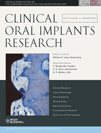Bone healing of critical-sized nasal defects in rabbits by statins in two different carriers
Abstract
Objectives: To evaluate bone healing following implantation of a statin with two different carriers in rabbit nasal bone using histological and immunohistochemical methods.
Materials and methods: Twenty adult, male Japanese white rabbits (age: 12–16 weeks, weight: 2.5–3 kg) were used in this study. Five bone circular defects (5 mm in diameter) per rabbit were created in the nasal bone while preserving the nasal membrane. In the experimental groups, 2.5 mg/ml simvastatin dissolved in 0.2 ml water with hydrogel was implanted in one group, 2.5 mg/ml simvastatin dissolved in 0.2 ml water with an atelocollagen sponge (ACS) in the second group with, only the hydrogel in the third group and only an ACS in the fourth group. No material was implanted in the control group. Four animals were killed in each period, at 1, 2, 4, 8 and 12 weeks postoperatively. The parts that had been operated on were removed and prepared for histological assessment. The expression of bone morphogenetic proteins (BMP)-2 and the bone ration was evaluated using histological and immunohistochemical methods.
Results: No significant differences were observed between the simvastatin with hydrogel group and the simvastatin with ACS group at 1, 2, 4, 8 and 12 weeks postoperatively regarding expression of BMP-2, although the number of cells that stained positive for BMP-2 in both of the implanted groups increased significantly at 2 and 4 weeks postoperatively in comparison with the control group (P<0.0001). For new bone area ratio, there were no significant differences between the simvastatin with hydrogel groups and the simvastatin with ACS group after 2, 4, 8 and 12 weeks, although these groups showed higher value than control group (P<0.0001).
Conclusion: This study suggests that both the simvastatin with hydrogel and simvastatin with ACS implants showed similar BMP-2 expression and new bone formation, and there were no significant differences between the two carriers.
To cite this article: Mukozawa A, Ueki K, Marukawa K, Okabe K, Moroi A, Nakagawa K. Bone healing of critical-sized nasal defects in rabbits by statins in two different carriers.Clin. Oral Impl. Res. 22, 2011; 1327–1335.doi: 10.1111/j.1600-0501.2010.02135.x




